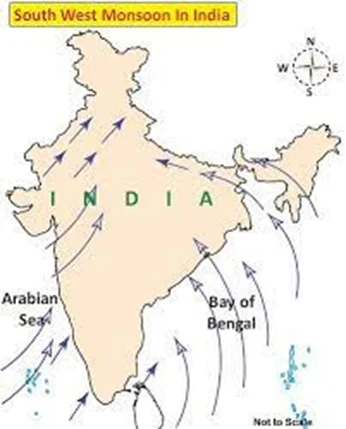Answer:
| Approach
Introduction
- Write about South-West Monsoon and its nomenclature around various regions.
Body
- Mention reasons behind calling the South-West Monsoon ‘Purvaiya’ (Easterly) in the Bhojpur Region
- Influence of Directional Seasonal Wind System on the Cultural Ethos of the Region
Conclusion
- Give appropriate conclusion in this regard
|
Introduction
The South-West Monsoon is a seasonal wind system that typically originates from the southwest direction and brings heavy rainfall during the summer months, thus significantly impacting the socio-economic landscape of the Indian subcontinent. It is recognized by various names across India, such as “Varsha Ritu” in Hindi and “Edavappathi” in Malayalam. In the Bhojpur Region, it is referred to as ‘Purvaiya (easterly),’ owing to the following reasons:

Body
Reasons Behind Calling the South-West Monsoon ‘Purvaiya’ (Easterly) in the Bhojpur Region:
- Geographical Orientation: The Bhojpur region, which is located in the eastern part of India, experiences the South-West Monsoon winds coming from the Bay of Bengal. These winds blow in from the east, which is why they are referred to as “Purvaiya,” meaning winds from the east.
- Historical Influence: The use of the term “Purvaiya” may have historical roots, where local communities and cultures developed their own names for weather phenomena based on their observations and experiences. Over time, these names became ingrained in the local culture and language.
- Linguistic Influence: “Purvaiya” originates from the Hindi language, and since spoken Bhojpuri is significantly influenced by Hindi, it has adopted this term. In Hindi, “Purv” signifies east, and the suffix “aiya” denotes direction or origin. Consequently, “Purvaiya” directly translates to “eastern winds.”
Influence of Directional Seasonal Wind System on the Cultural Ethos of the Region:
- Cropping: The South-West Monsoon determines the cropping calendar of the Bhojpur region. Farmers eagerly await its arrival to begin planting various crops, including staples like rice and wheat. Rituals like “Kheti-Bari” celebrate this crucial event, emphasizing the close relationship between agriculture and the monsoon.
- Attire: Traditional clothing in Bhojpur is designed to withstand the monsoon weather, with lightweight, breathable fabrics chosen to provide comfort during heavy rains. For instance, men often wear “dhotis” and “kurta,” while women prefer “sarees”.
- Cuisine and Food Practices: The monsoon influences the culinary traditions of the region, with certain dishes like “pakoras” and “khichdi” becoming popular during this season for their warmth and comfort.
- Folk Songs and Music: In Bhojpur, folk songs and music often celebrate the arrival of the monsoon, highlighting the joy and relief brought by the monsoon rains. For example, the popular folk song “Barso Re” is a vivid expression of this cultural celebration of the monsoon’s arrival.
- Festival and Fairs: Festivals like “Teej” and fairs like “Chaiti Mela” are timed with the monsoon, showcasing the deep cultural significance of rain in the Bhojpuri region. These events often feature processions, dances, and performances that celebrate the region’s cultural diversity, emphasizing the importance of the monsoon in the local cultural ethos.
- Language and Literature: The seasonal wind system and its impact on climate and nature serve as prominent themes in Bhojpuri language and literature. Poem “baras jaait paani” (“बरस जाईत पानी”) exemplifies this.
Conclusion
‘Purvaiya’ encapsulates the spirit of the Bhojpur Region, where the monsoon is not just a weather pattern but a cultural heartbeat. It underscores the resilience and adaptability of its people and serves as a reminder of the enduring relationship between nature and culture in this remarkable part of India.
